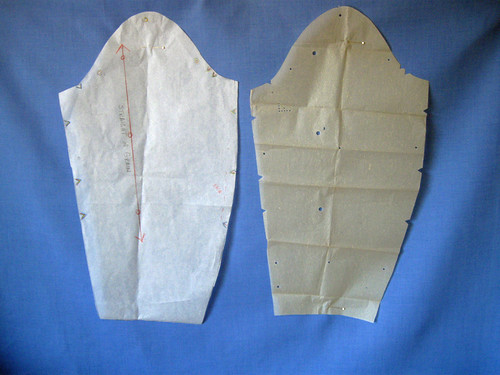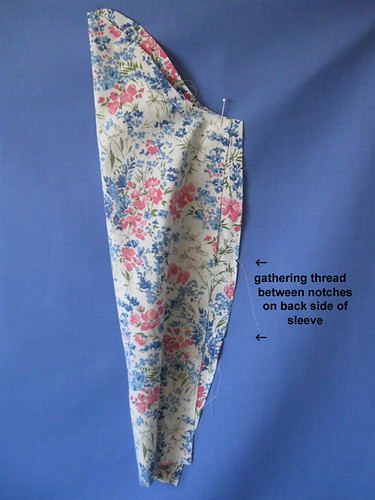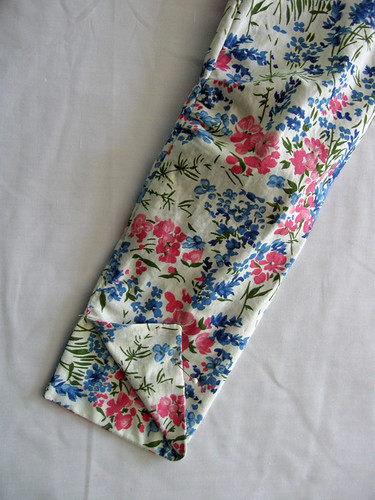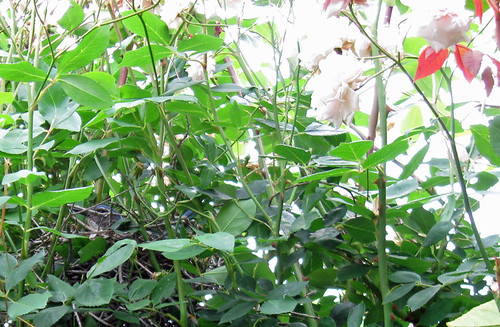Thankfully I did learn a bit, and by sophmore year of high school was turning out all manner of prom dresses. I think senior year I made a Vogue designer pattern in two tones of green, an avant-garde style that probably wasn't really suited for a prom but might have looked right at a museum fund raiser.
So when I cut out the sleeves on this 2-piece vintage outfit it reminded me of this detail that is an important construction element I used to ignore.
Here is a look at the sleeve pattern piece. On the right is the original, and the left is my tissue paper tracing. I like to copy all the pattern pieces on these vintage patterns, they often are very fragile and these very old ones have no printed markings, a fact that really threw me the first time I opened one up. It took me a while to figure out that the 3 big holes marked the straight of grain line on the pattern pieces.
See how the notches in the center of each side seam have different spacing. The back part of the sleeve is meant to be eased into the seam to create a curve and a bit of ease where the elbow bends. You know it is the back of the sleeve, because in the sleeve cap there is a double notch on the back of the sleeve. I like how sewing has these conventions that remain the same across decades and different pattern companies. If you have a double notch in the sleeve cap - that is the back of the sleeve. A reassuring feature and very useful. For some reason I have made more dumb mistakes on sleeve insertion that any other part of a garment. Such as the ever popular attaching sleeve backwards, or sewing 2 left sleeves. I could go on.
Here is the sleeve as cut out. The front seam length is visibly shorter than the back seam
and needs that little bit of gathering to make it the same length as the front. In those early years, I used to just sew it up and slice off the extra bit at the bottom. Perhaps I ended up walking around with my arms stiffly held at my side like Frankenstein - can't recall or supressed those memories.
On the right is the sleeve with the seam sewn.
The slight curve of the sleeve is now visible, and there is room in the elbow for movement.
For the bottom of the sleeve, I made what I consider a "faux cuff" not really an attached sleeve cuff, but a way to turn up the bottom of the sleeve into a cuff. This sleeve is very narrow at the bottom, so I left the seam open at the bottom about 4 inches. I cut a copy of the sleeve using the bottom about 8 inches or so and sewed it on as a facing. That way there is a small opening, about 3 inches and the end of the sleeve can be turned up like a cuff, with the right side of the fabric showing. It doesn't really have the opening at the outside as it would on a real cuff, but it gives the look of a cuff or turned back sleeve and finished off the hem nicely.
Here is a small peek on the dress form. Next post - finished garment and photos of Nancy wearing her outfit.
Today's SunnyGal garden photo, in keeping with my pink and blue theme, I noticed a lot of activity in a pink climbing rose bush (Cecile Brunner rose) which grows between the orange and lemon trees. When the light was just right I happened to glance over and realized there is a very big nest there with a patiently waiting blue jay, and her frequently visiting mate. I was picking the oranges and lemons yesterday and she did not budge. This photo makes me think of Robert De Niro (for you film buffs out there), and yes, I am looking at you. Hope to see some baby birds soon.

















I can't wait to see the finished outfit! I absolutely love the floral fabric you're using. I agree wholeheartedly with you. It's a good idea to practice good construction techniques because it does make all the difference.
ReplyDeleteIt's going to be wonderful! I love the collar detail particularly...
ReplyDeleteWhat wonderful springtime colors in this fabric. That collar has enchanted me as well.
ReplyDeleteOh this is going to be so very lovely! The fabric is very pretty and your construction is superb.
ReplyDeleteAren't you in California? I don't think Blue Jays go that far west. Maybe a Steller's Jay?
ReplyDeleteThat turned out nicely. Really like that collar.
ReplyDelete